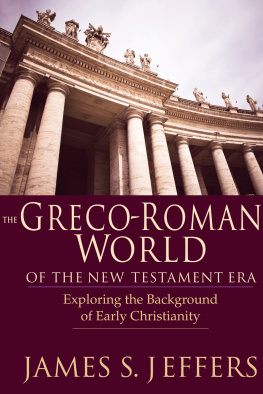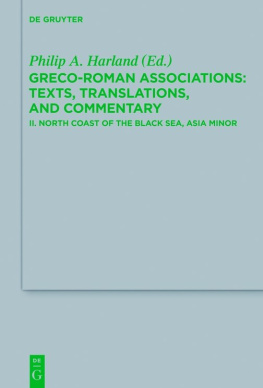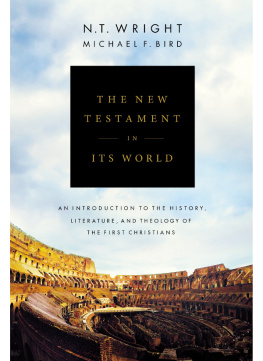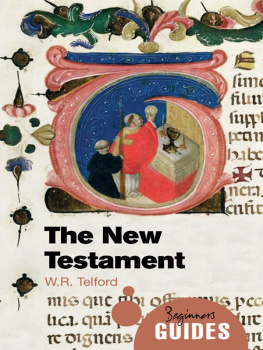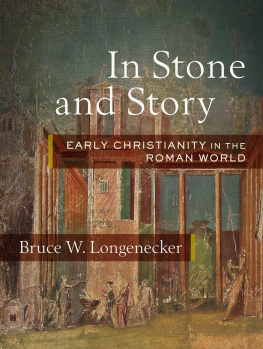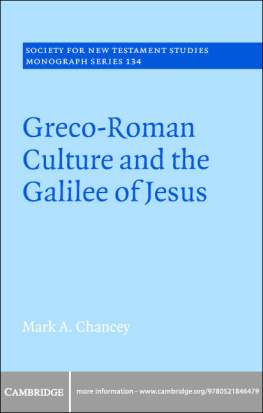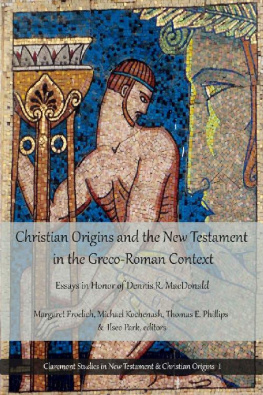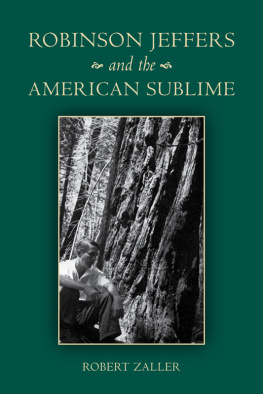James S. Jeffers - The Greco-Roman World of the New Testament Era: Exploring the Background of Early Christianity
Here you can read online James S. Jeffers - The Greco-Roman World of the New Testament Era: Exploring the Background of Early Christianity full text of the book (entire story) in english for free. Download pdf and epub, get meaning, cover and reviews about this ebook. year: 1999, publisher: InterVarsity Press / IVP Academic, genre: Romance novel. Description of the work, (preface) as well as reviews are available. Best literature library LitArk.com created for fans of good reading and offers a wide selection of genres:
Romance novel
Science fiction
Adventure
Detective
Science
History
Home and family
Prose
Art
Politics
Computer
Non-fiction
Religion
Business
Children
Humor
Choose a favorite category and find really read worthwhile books. Enjoy immersion in the world of imagination, feel the emotions of the characters or learn something new for yourself, make an fascinating discovery.
- Book:The Greco-Roman World of the New Testament Era: Exploring the Background of Early Christianity
- Author:
- Publisher:InterVarsity Press / IVP Academic
- Genre:
- Year:1999
- Rating:4 / 5
- Favourites:Add to favourites
- Your mark:
- 80
- 1
- 2
- 3
- 4
- 5
The Greco-Roman World of the New Testament Era: Exploring the Background of Early Christianity: summary, description and annotation
We offer to read an annotation, description, summary or preface (depends on what the author of the book "The Greco-Roman World of the New Testament Era: Exploring the Background of Early Christianity" wrote himself). If you haven't found the necessary information about the book — write in the comments, we will try to find it.
James S. Jeffers: author's other books
Who wrote The Greco-Roman World of the New Testament Era: Exploring the Background of Early Christianity? Find out the surname, the name of the author of the book and a list of all author's works by series.
The Greco-Roman World of the New Testament Era: Exploring the Background of Early Christianity — read online for free the complete book (whole text) full work
Below is the text of the book, divided by pages. System saving the place of the last page read, allows you to conveniently read the book "The Greco-Roman World of the New Testament Era: Exploring the Background of Early Christianity" online for free, without having to search again every time where you left off. Put a bookmark, and you can go to the page where you finished reading at any time.
Font size:
Interval:
Bookmark:
THE GRECO-ROMAN
WORLD
OF THE NEW TESTAMENT ERA
Exploring the Background
of Early Christianity

InterVarsity Press
P.O. Box 1400, Downers Grove, IL 60515-1426
World Wide Web: www.ivpress.com
E-mail:
1999 by James S. Jeffers
All rights reserved. No part of this book may be reproduced in any form without written permission from InterVarsity Press.
InterVarsity Press is the book-publishing division of InterVarsity Christian Fellowship/USA, mpus at hundreds of universities, colleges and schools of nursing in the United States of vement of the International Fellowship of Evangelical Students. For information abo rite Public Relations Dept., InterVarsity Christian Fellowship/USA, 6400 Schroede I 53707-7895, Madison, WI 53707-7895, or visit the IVCF website at .
All Scripture quotations, unless otherwise indicated, are taken from THE HOLY BIBLE, NEW INTERNATIONAL VERSION, NIV Copyright 1973, 1978, 1984, 2011 by Biblica Inc.tm Used by permission. All rights reserved worldwide.
Design: Cindy Kiple
Image: Giorgio Fochesato/iStockphoto
ISBN 978-0-8308-7802-4 (digital)
ISBN 978-0-8308-1589-0 (print)
This digital document has been produced by Nord Compo.
This book is dedicated to ministers
and lay Christians who,
in the midst of ministry challenges
and hectic schedules,
still make the time to understand
what the New Testament means
in the various contexts in which
its parts were written,
and who believe
that a Christian
never need fear the pursuit of truth.
Most Christians and others interested in the New Testament would love to be able to read it and understand what it means without having to read other books. Of course, one can always read some kind of meaning into a verse of Scripture. But those who understand that the books of the New Testament were written to specific people, in specific places, nearly two thousand years ago, know that this is not a good idea. If the New Testament texts were written to make sense to people in the first century, then we must try to put ourselves into their places in order to determine what the writers of the New Testament intended their readers to understand by what they wrote.
If we try to make sense of the Bible with no knowledge of the people who wrote it, those who read it and the society in which they lived, we will be inclined to read into the Scriptures our own societys values and ideas. This would be a major mistake since our culture is very different from that of the ancient Romans.
This book is written with the nonscholar in mind. It uses technical terms only when necessary to make the point, and then explains them clearly. This does not mean, however, that the book is not suitable for the serious student. I am convinced that one does not have to sacrifice accuracy to make a work understandable to the inexpert.
Many Bible background books have been written over the years, but few have addressed thoroughly what the student of the New Testament needs to know about Greco-Roman societies and cultures of the time. Still fewer have been written by someone with expertise in both Roman history and early Christianity.
The birthplace of Christianity was a very complex and complicated place in the first century. Chapter one introduces the cultural and political milieu by means of a fictional dinner in Jerusalem. For those who want a fuller account, appendix A presents the Roman and Hellenistic historical background, with attention to themes and events such as the conquest of the eastern Mediterranean that will help place the early church in the Greco-Roman context. Chapter two tries to give the reader a sense of what it was like to live in the first century with a look at how the people of the day worked, played, traveled, ate, clothed themselves and attended to the deceased.
Although most of the population of the day lived in the countryside, Christianity arose in the cities of the Empire. So chapter three focuses on the city and city life in the Greco-Roman world and its impact on the early churches. Consult chapter thirteen for descriptions of the various cities and Roman provinces and their significance in the New Testament era. Chapter four looks at how the early Christians organized themselves within the cities and considers to what extent the synagogue, the Roman voluntary association, and Roman household structures may have affected the development of early church organization.
Religion was a very important element of life in the ancient world. Chapter five presents a brief overview of the key religions of the day. It shows how the Romans and others looked at religion, and how this affected Judaism and Christianity.
The next two chapters look at how the Romans ruled the Empire they assembled. Chapter six describes how Rome governed its provinces, with special attention to Palestine and the Near East. Chapter seven examines some of the key tools that the Romans used to control and administer their empire: taxes, the legal system and the military.
We cannot understand the connection between Christianity and Greco-Roman society until we realize the importance of honor and respect in the social order. The next several chapters address the various issues that contributed to a persons social standing and how these issues affected Christians of the New Testament era. Chapter eight looks at social class and the complex way in which status was measured. Chapter nine examines the importance of citizenship, chapter ten presents the position of the Jews in the cities of the Empire, and chapter eleven shows the significance of slavery to ancient society and how its presence affected the first Christians.
An understanding of how peoples in the Roman Empire organized themselves privately also sheds light on the early Christian congregations. Chapter twelve surveys the family, the place of women, and education in the Roman world. It examines how New Testament comments about these topics relate to Roman ideas and practices.
Appendix B is a timeline of the events and persons described in this book. An index of Scripture passages is supplied to help the reader find comments related to a Bible passage he or she may be studying.
This work uses the phrases New Testament era and first century A.D. (or simply first century) to refer to the same period. Something also needs to be said about how I use the term Greco-Roman. Scholars generally use this term to refer to the interaction of Roman culture and society with Greek/Hellenistic culture and society, a process that began several centuries before the time of Christ. Sometimes this was a blending of ideas; other times it involved sharp opposition of ideas. But by the first century A.D., the Romans were in firm control of the eastern (as well as western) Mediterranean basin. So when we talk about the New Testament era in that area, we are talking about a society still influenced by Hellenistic ideas, customs, religion and language but dominated by Roman law, governmental forms, ideas of class and status, and the military. It was beginning to be influenced by Roman cultural values as well. So this book does not present a full-blown account of Hellenistic society and culture; rather it tries to present this society within the context of Roman control, hopefully in the way that Christians in the first century would have experienced it.
I would like to thank my editor at InterVarsity Press, Daniel G. Reid, for his invaluable help and support during the editing process. I am also in the debt of Craig S. Keener for his timely suggestions and enthusiasm about the manuscript. J. P. Moreland offered me the encouragement of a true friend and the insights of a gifted scholar. Finally, I want to thank my wife, Bonnie, for helping me think through this project at every point from its inception some five years ago.
Font size:
Interval:
Bookmark:
Similar books «The Greco-Roman World of the New Testament Era: Exploring the Background of Early Christianity»
Look at similar books to The Greco-Roman World of the New Testament Era: Exploring the Background of Early Christianity. We have selected literature similar in name and meaning in the hope of providing readers with more options to find new, interesting, not yet read works.
Discussion, reviews of the book The Greco-Roman World of the New Testament Era: Exploring the Background of Early Christianity and just readers' own opinions. Leave your comments, write what you think about the work, its meaning or the main characters. Specify what exactly you liked and what you didn't like, and why you think so.

